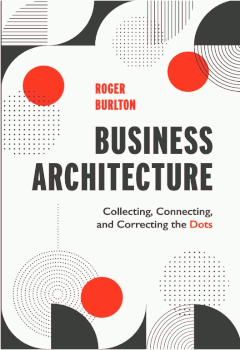Updated:
Updated: Architecture
I have long considered business architecture a key element of enterprise architecture, going as far as publicly stating that enterprise architecture connects business and IT architecture in my most popular talks on Enterprise Architecture:

After the notion of business architecture started gaining traction some years ago, I picked up a book to learn more about it. Sadly, the book spent more pages pointing out the perceived shortcomings of IT architecture than showing how business architecture addresses them. It seemed like the authors had an axe to grind with IT architects and were keen to publish a “we matter, too” proclamation. After spending a bit more time with the topic, I found this sentiment to be oddly widespread. Time for a (gentle) rant…
The Guild
The natural starting point for business architecture is the Business Architecture Guild, which describes its mission as follows:
The Business Architecture Guild has brought together a cadre of thought leaders with vision, experience and innovative ideas. We have introduced a body of knowledge, collaboratively produced and managed by practitioners and subject-matter experts.
Purported authority (provided by the cadre of thought leaders, no less) appears to come ahead of a description of actual problems being solved, but let’s not judge prematurely. We soon get a hint of the strong views held by the site owners in a surprising location: the cookie banner. As on most sites, you have a choice to accept or decline cookies, but the Deny button has a special meaning: it denies you access to the content by swiftly taking you to Google’s home page, as evidenced by the HTML source:
<button id="openglobal_privacy_leave" onclick="window.location='https://www.google.com/';">Deny</button>
So, it’s my way or the (information super-) highway, apparently. In any case, once you deny, it’s easy to search for other web pages on the topic.
If you feel agreeable, you find out more about the benefit of business architecture:
Business architecture allows everyone – from strategic planning teams through implementation teams – to get “on the same page”, enabling them to address challenges and meet business objectives.
Perhaps the guild’s website is that same page? The need for alignment across levels is much appreciated and the driver behind the concept of the Architect Elevator. But there are bound to be a slew of approaches that “address challenges” and “meet business objectives”. I definitely felt like I was leaving intellectually empty-handed (I later found a more detailed definition in the BIZBOK samples—you have to be a paying member to get access to the full document).
From Strategy to Reality
 Looking further for insights on business architecture, we quickly stumble upon Strategy to Reality: Making the Impossible Possible for Business Architects, Change Makers and Strategy Execution Leaders. Once again, a tad heavy on promises: we’re doing no less than make the impossible possible. Admittedly, aligning strategy to implementation can seem impossible at times. Nevertheless, 4.4 stars hint at some useful content and at $12 it’s quite the steal.
Looking further for insights on business architecture, we quickly stumble upon Strategy to Reality: Making the Impossible Possible for Business Architects, Change Makers and Strategy Execution Leaders. Once again, a tad heavy on promises: we’re doing no less than make the impossible possible. Admittedly, aligning strategy to implementation can seem impossible at times. Nevertheless, 4.4 stars hint at some useful content and at $12 it’s quite the steal.
We also find a bit more to work with regarding the role of business architecture:
Business architecture tells us how an organization is structured to deliver value to its customers and support its operations.
Structuring an organization sounds a bit like organizational design, but it’s certainly more concrete than “getting on the same page”. Alas, it appears that the community prefers getting on the same page. It also loves dishing out, as revealed in this review by a seemingly grumpy business architect:
“This book tries to ride the already dead horse Enterprise Architecture. It repeats topics from the 10 year old work of the Business Architecture Guild and adds nothing new. No practical patterns. Theoretical.”
Hear, hear! Enterprise Architecture is a dead horse. But perhaps Business Architecture is a donkey, so we’re still a bit jealous of that dead horse, aren’t we? And we’re looking for practical patterns, as opposed to impractical ones, I suppose? And theory is for losers! After all, we just want to get on the same page–much more pragmatic! If the book indeed repeats topics from the “Guild”, it shouldn’t be so bad, should it? Unless the work by the Guild is also theoretical and lacking practical patterns…
It appears that these business architect folks are light on definitions but heavy on throwing stones, even at each other.
Business Architecture—The Book
The first book that I read on business architecture actually carried the promising title Business Architecture (by Ulrich and McWhorter). Sadly, I was disappointed by the repeated elaboration of the shortcomings of IT architecture, which apparently left no space to describe how business architecture would do a better job. My summary was:
The first 40 pages talk more about the limitations of IT architecture than the benefits of business architecture. This is rather tedious.
Reviews by other readers suggest that I was not alone in my impression:
This book motivates what Business Architecture might be some day. The authors lay out WHAT could be achieved with it. But they don’t show HOW to do it.
I tend to lend more credibility to Goodreads scores than Amazon ones (authors tend to invite all their friends to write glowing reviews on Amazon but forget about Goodreads), and this book doesn’t fare too well with a score of 3.69.
I should have read the back cover first because it reveals a similar narrative: “enterprise architecture turns off business professionals”, so apparently the domain of enterprise transformation has to be reclaimed from IT to “put the business back in the driver’s seat”:

The authors’ mindset reminds me of the sports dude fraternity in Revenge of the Nerds. I would not have suspected as much, but it appears that IT architects have claimed enterprise transformation for themselves, leaving business architects in second place, which apparently they don’t fancy.
Connecting the Dots
 With a little more poking around, we find more nuanced views on business architecture, for example in Business Architecture: Collecting, Connecting, and Correcting the Dots by Burlton, which points out that:
With a little more poking around, we find more nuanced views on business architecture, for example in Business Architecture: Collecting, Connecting, and Correcting the Dots by Burlton, which points out that:
EA models have gradually incorporated business and operational perspectives in addition to IT ones.
This is more in line with my view of EA needing to span both IT and organizational topics to be effective. Sadly, we see many examples of modern technology coming to a grinding halt due to mismatching processes or organizational structures.
Business Architecture Without Business Architects?
One important insight in IT architecture is that you always have an architecture, whether you have architects or not. The same line of thought should apply to business architecture: every business has an architecture, for example expressed in its organizational structure, product lines, divisions, etc. How would this architecture come about without business architects? In most organizations the answer is straightforward: the architects of the business don’t go by the title of “business architect” but more likely by “head of strategy”, “organizational planning”, or even “COO”, Chief Operating Officer.
Making this discipline of architecting the business more tangible is certainly a noble endeavor, but filling this gap doesn’t need to “reclaim” anything from IT architecture. The list of enterprise challenges leaves plenty of room for everyone!
At least Amazon believes in fruitful co-existence of the domains by recommending the following bundle (I personally would add The Software Architect Elevator, but readily admit my bias):

Be a Cooler Architect
And just for kicks, I found this great illustration on the Internet how anyone can look like a cool architect:

Make More Impact as an Architect

The Software Architect Elevator helps architects and IT professionals to take their role to the next level. By sharing the real-life journey of a chief architect, it shows how to influence organizations at the intersection of business and technology. Buy it on Amazon US, Amazon UK, Amazon Europe